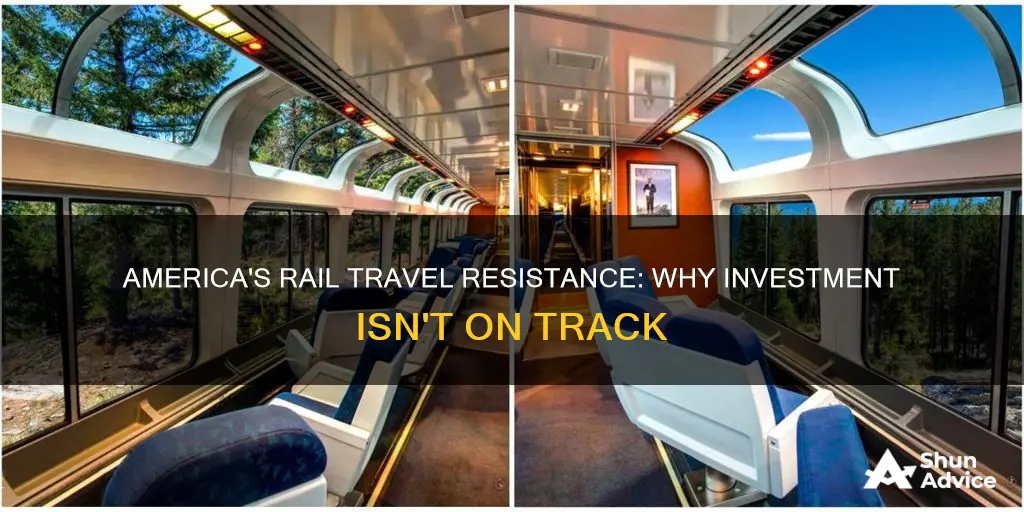
Despite being a pioneer in passenger train travel in the 19th century, the United States has fallen behind other wealthy nations when it comes to investing in high-speed rail infrastructure. While countries like Japan, France, and China have successfully implemented high-speed rail networks, the US has largely neglected this mode of transportation in favour of highways and aviation. This trend can be attributed to a variety of factors, including the country's car culture, political stagnation, and the high costs associated with constructing and maintaining rail infrastructure.
The US currently has the most railroad tracks in the world, but the majority of this infrastructure is used for freight transportation. After World War II, the focus of infrastructure spending shifted towards highways and aviation, causing railways to decline. This shift was influenced by government spending on national highway programmes, aviation industry subsidies, and other transportation modes, while passenger rail received little to no taxpayer support. As a result, private rail companies were burdened with the full cost of maintenance and construction projects, hindering the development of a robust passenger rail network.
In recent years, there has been a growing recognition of the benefits of high-speed rail, including reduced travel times, environmental advantages, and economic revitalisation outside urban centres. However, the challenges of implementing such projects in densely populated areas, along with the high costs and political opposition, have slowed down progress.
| Characteristics | Values |
|---|---|
| Lack of federal will | The federal government has not prioritised investment in rail travel. |
| Car culture | The US has a "car culture" due to decades of subsidising other modes of transportation. |
| Cost | High-speed rail is expensive to build and maintain. |
| Inefficiency | High-speed rail is slower than flying and less convenient than driving. |
| Lack of demand | There are not enough conventional train riders for high-speed rail lines to succeed. |
| Misconceptions | There is a stigma associated with passenger trains due to misconceptions about their expense. |
| Political corruption | High-speed rail is a tempting target for people looking to divert government funds for their own gain. |
What You'll Learn

Lack of federal will
The United States' lack of federal will to invest in rail travel is a significant factor in its failure to develop a high-speed rail network. Despite being a pioneer in passenger train travel in the 19th century, the country's focus shifted to highways and aviation after World War II, leading to the decline of railways. This trend has continued, with highways requiring continuous maintenance and expansion to accommodate the growing population. As a result, rail infrastructure has been neglected, and in 2021, only 19% of transportation and infrastructure spending in the US was allocated to rail.
The federal government's lack of commitment to rail development is evident in various instances. For example, in Wisconsin, a proposed high-speed rail project between Madison and Milwaukee received an $800 million grant from the federal government under President Obama. However, Scott Walker, who campaigned against the project, was elected governor and redirected the funding to roads and bridges instead. This lack of consistent support and political will at the federal level hinders the development and improvement of rail travel in the US.
Another example of the lack of federal will is the stagnation of the issue in Washington. Despite the benefits of faster and more efficient train systems, there is a general stigma associated with passenger trains due to the misconception that they are incredibly expensive and require significant taxpayer subsidies. This stigma has led to a lack of political movement and support for high-speed rail projects. Additionally, some argue that high-speed rail is not suited for the US due to the presence of interstate highways and the fragmentation of destination points, neglecting to consider future population growth and the need for more environmentally friendly transportation options.
Furthermore, the federal government has prioritized other modes of transportation over rail. In the late 1950s, the US government spent billions of dollars on a national highway program, aviation industry subsidies, and canal projects, while the passenger rail industry received no taxpayer support. Private rail companies were left to bear the financial burden of maintenance and construction projects, hindering their ability to invest in improving rail infrastructure.
The lack of federal will to invest in rail travel also stems from the belief that high-speed rail is an obsolete technology. Critics argue that high-speed rail requires expensive and dedicated infrastructure that will only serve the purpose of moving passengers, who could more economically travel by highway or air. They claim that high-speed rail is slower than flying, less convenient than driving, and more expensive than both. Additionally, there are concerns about the environmental benefits of high-speed rail, especially in regions where electricity is generated by burning fossil fuels.
In conclusion, the lack of federal will to invest in rail travel in the US is evident through the historical neglect of rail infrastructure, political stagnation, misconceptions about cost and suitability, and the prioritization of other modes of transportation. This lack of federal commitment has hindered the development of a high-speed rail network in the country, despite its potential benefits in terms of efficiency, environmental impact, and economic growth.
The Great Debate: Mortgage vs. Invest – Where Should Your Money Go?
You may want to see also

High-speed rail is expensive
The high cost of high-speed rail projects in the United States can be attributed to several factors. One reason is that costs related to healthcare and pensions are incorporated into the direct capital cost of projects in the US, whereas in other countries, these costs are covered by general taxation. The presence of high-methane zones in the underground environment around Los Angeles is another factor that drives up project costs in California.
The construction of high-speed rail also takes a significant amount of time. The California High-Speed Rail project, for example, has experienced delays and is expected to take nearly 40 years from planning to completion.
Furthermore, high-speed rail projects often face cost overruns, with expenses exceeding initial projections. California's high-speed rail project, which was initially estimated to cost $25 billion, has seen its budget more than double to $105 billion. This is a common occurrence, as costs tend to escalate during the construction process.
In addition to the high construction costs, the ongoing maintenance and operation of high-speed rail systems can also be costly. The extensive infrastructure required for high-speed trains must be maintained to extremely precise standards, incurring substantial maintenance expenses.
The expense of high-speed rail is a significant barrier to its implementation and a reason why the United States has been hesitant to invest heavily in this mode of transportation.
Strategic Retirement: Navigating the $6 Million Investment Journey
You may want to see also

High-speed rail is obsolete
High-speed rail is often deemed obsolete due to the advent of air travel, which has rendered it slower and less convenient than flying. In 1958, the introduction of the Boeing 707 jetliner marked a significant shift, as these planes could reach speeds twice as fast as the fastest trains today. While high-speed rail has its advantages, such as connecting smaller cities and offering a more comfortable journey, the high cost of building and maintaining the necessary infrastructure makes it expensive to operate and challenging to justify economically.
The construction of high-speed rail lines requires a significant investment, and the tracks must be rebuilt every 20 to 30 years, incurring additional costs. In the case of California's high-speed rail project, the cost per mile was $100 million, and it is predicted that building in hilly areas would cost at least $170 million per mile. The high cost of tickets on high-speed rail, compared to air travel, further contributes to the perception of obsolescence.
However, supporters of high-speed rail argue that it offers benefits beyond speed. High-speed trains are marvels of engineering and innovation, with modern trains providing a quiet, smooth, and productive travel experience. They also contribute to economic growth and connectivity by linking small, mid-sized, and large cities, promoting density, walkability, and thriving downtown areas. Additionally, high-speed rail is a safer mode of transportation, with advanced systems reducing the risk of fatalities or injuries to near zero.
Despite these advantages, high-speed rail faces challenges in terms of cost and speed compared to other modes of transportation. The construction and maintenance of the required infrastructure are significant financial burdens, and the speed of high-speed rail is outpaced by air travel, making it less attractive for long-distance journeys. As a result, high-speed rail is often considered obsolete, especially when compared to more efficient and cost-effective alternatives.
Furthermore, the environmental benefits of high-speed rail are questionable. While it is true that high-speed rail is more energy-efficient than travelling by car, the construction of these rail lines releases thousands of tons of greenhouse gases into the atmosphere. Additionally, the electricity used to power high-speed trains may come from non-renewable sources, further contributing to their environmental impact.
Reliance Industries: Invest Now?
You may want to see also

High-speed rail is inefficient
Secondly, high-speed rail systems often carry relatively few passengers, especially when compared to other transportation modes such as air travel or highways. This low passenger volume makes it challenging to justify the high costs of building and operating these systems.
Thirdly, high-speed rail is often incompatible with freight transport, which is a crucial aspect of the transportation system in the United States. Most of the railroad tracks in the US are used for freight transport, and high-speed rail dedicated infrastructure does not provide any improvements in this area.
Additionally, the United States faces unique challenges when it comes to implementing high-speed rail. The distance between major population centers in the US is much greater than in countries with successful high-speed rail systems, such as China, Europe, and Japan. This distance makes it more difficult to justify the high costs of building and operating high-speed rail systems. Furthermore, the US has a strong "car culture," with a long history of subsidizing other modes of transportation such as highways and aviation while neglecting rail infrastructure.
Lastly, the legal and procedural hurdles in the US make it difficult to build high-speed rail. The ability of citizens to tie up the government in eminent domain appeals, environmental reviews, and other legal challenges can delay projects for decades and increase costs significantly.
Ebooks: Eco-Friendly, Accessible, Affordable
You may want to see also

High-speed rail is unpopular
Cultural Factors
The US has a strong strong "car culture", with many Americans preferring to drive even in heavily populated metropolitan areas. This preference for cars is partly due to decades of subsidizing other modes of transportation such as highways, aviation, and canals, while not providing similar support for rail. As a result, rail infrastructure has lagged behind, and Americans have become accustomed to travelling by car or plane.
Additionally, train stations in the US are often old and located near city centres, making it inconvenient for those who need to drive to the station and park their cars.
Economic Factors
The US has a low population density, especially in the West, with vast distances between cities. As a result, high-speed rail struggles to compete economically with air travel. The construction of new high-speed rail tracks would require significant investment and face challenges such as land acquisition and environmental concerns.
Political Factors
The US government has historically neglected passenger rail, with freight railroads flourishing while passenger rail has been a low priority. Powerful airline, oil, and auto industry lobbies have also contributed to the lack of support for high-speed rail.
Furthermore, the privatization of the rail system and the focus on short-term profits have hindered the development of high-speed rail. Political opposition and waning public support for costly projects, such as the California High-Speed Rail, have also contributed to the unpopularity of high-speed rail.
Investing Strategies: Where to Place Your Money in a Downturn
You may want to see also
Frequently asked questions
America has a car culture and has spent billions of dollars subsidising other modes of transportation, such as highways and aviation, while the rail industry has received no taxpayer support.
There are several cultural, economic and environmental benefits to having a solid passenger rail infrastructure. Train travel offers cheaper transportation for budget travellers and provides more ways for financial wealth to spread. It is also better for the environment, with Amtrak being 46% more energy-efficient than travelling by car.
There is a stigma associated with passenger trains because of the fallacy that they are incredibly expensive, requiring taxpayer subsidies. There is also a misconception that high-speed rail is not suited for the United States as interstate highways shorten travel times and air travel is quicker and more flexible for long distances.







